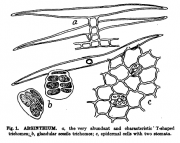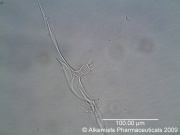Introduction
Macroscopic Entries
Microscopic Entries
| Wormwood (leafy tops) (Absinthium vulgare Lam., Compositae.)The most distinctive tissue elements are the very abundant T-shaped, rather thin-walled trichromes with three to four basal cells; the rather large, yellowish, sessile, glandular trichromes with several vertical tiers of cells, are also quite diagnostic some pollen grains presenting the characteristics of the pollen of the order Compositae will generally be found. The vertical walls of the epidermal cells are wavy or sinuate and the stomata are abundant and fairly large.
Compare with Achilea and insect powder which are similar in certain of the histological characteristics.
Source: Schneider, A. (1921) The Microanalysis of Powdered Vegetable Drugs, 2nd ed. [1]
|
|
|
|
| T-shaped trichromes with three to four basal cells in 400X Acidified chloral Hydrate Soln.The most distinctive tissue elements are the very abundant T-shaped, rather thin-walled trichromes with three to four basal cells as well as the strap-shaped tubular covering trichomes.400X Acidified chloral Hydrate Soln.
Source: Elan M. Sudberg Alkemists Labs. and British Pharmacopoeia, 2003 [2]
|
|
|
|
HPTLC Entries
Other Points of Interest
Cite error: <ref> tags exist, but no <references/> tag was found

